FEATURED PRODUCTS
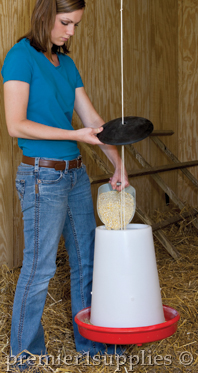
Fill poultry feeders easily by using our TurboScoop. This feeder can also be used outside with Premier's rain hat (not shown).
Handy Feeders - 26 lb capacity
Sturdy construction and high-quality plastic make the feeder suitable for all types of chickens, game birds and waterfowl. Clever adjustable internal carry handle controls feed flow and also enables hanging the feeder.
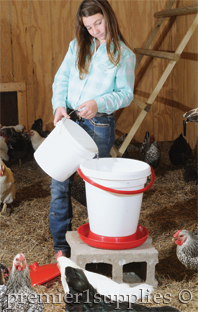 QuickClean - 5 gal capacity
QuickClean - 5 gal capacity
Many like this waterer because it's easy to clean and refill. The waterer is filled from the top, eliminating the need to flip it over to refill it. Its large capacity (5 gal) is useful for large flocks or less frequent refillings.
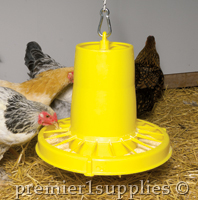 Saturn Feeder - 15 lb capacity
Saturn Feeder - 15 lb capacity
Since switching to this feeder, we've noticed a reduction in feed waste. The feed flows down as needed, but the birds can't scratch it out onto the floor. And the feed stays clean because the feeder is hanging above the litter.
By Premier staff
PREMIER TIP
Prevent Illness
Compost all kitchen and garden scraps that your birds are not interested in eating. This prevents their run or grazing area from becoming cluttered and reduces the risks of disease and pests (flies).
|
 |
 |
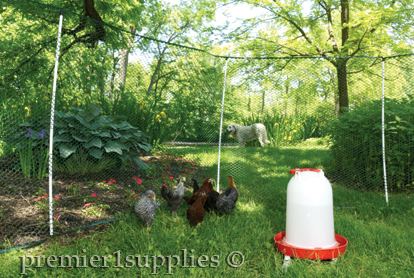
Grazing alongside the backyard landscaping at Premier. Even though the birds can forage, make sure to provide plenty of feed and water to fill their needs.
Out of the brooder and
into the pasture
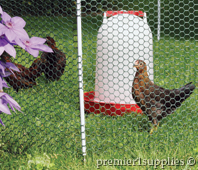
A light brown Leghorn pullet enjoys the view (but not the taste) of some lovely clematis.
|
Our spring chickens have found their way out of the brooder to the backyard. Young pullets and cockerels are enjoying their days foraging alongside the garden for nutritious bugs and grubs. The birds are still too small for the 3" spacings of PoultryNet™ or PermaNet®. As of now we are keeping them contained with NoShock Chick Fence. This works for keeping the birds in. To keep predators out, we surround the area with electrified PoultryNet.
The garden has also been quite bountiful. This means our kitchens are currently producing a surplus of peelings and table scraps. If you’re in the same situation, McMurray Hatchery has a handy article (below) on feeding kitchen scraps to your birds. Articles from Auburn University on poultry nutrition and Purdue University on pest control are also included in this mailer.
|
POULTRY NUTRITION
Poultry Nutrition and Feeding
Copyright© 2009 by Lee I. Chiba, Auburn University
In this article you will find information regarding nutrition and feeding for any of the domesticated and commercialized types of birds used for the production of eggs and (or) meat for human consumption.
Read More »
|
TABLE AND GARDEN SCRAPS
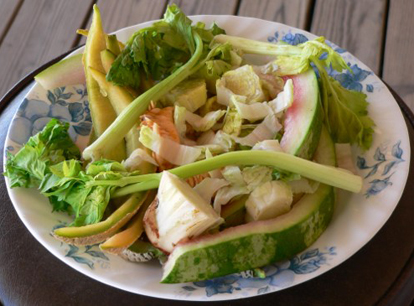 Feeding Your Chickens Table Scraps
Feeding Your Chickens Table Scraps
By Murray McMurray staff
www.mcmurrayhatchery.com
Chickens like to eat table scraps, and most of the leftovers from your meals are safe for them to eat. Table scraps alone don’t form a balanced diet for your chickens, so you should use them as a supplemental treat, not the main course, and you should feed them in moderation.
Most table scraps are lower in protein than commercial grower rations. Since baby chicks need plenty of protein to grow and develop properly, we recommend that you wait until chickens are about 3-4 months old before introducing table scraps.
Foods that are Safe to Feed Your Chickens
| • |
Bread – Bread, in moderation, can be fed to your chickens, but avoid moldy bread.
|
| • |
Cooked meats – Meats should be cut into small pieces.
|
| • |
Corn – Raw, cooked, or dried corn can be fed to your chickens.
|
| • |
Fruits – Aside from a few exceptions, most fruits are fine to feed your chickens. Suggestions are apples, berries, and melons (watermelon rinds are one of the favorites with our chickens).
|
| • |
Grains – Rice, wheat, and other grains are fine for your chickens.
|
| • |
Oatmeal
|
| • |
Peas
|
| • |
Vegetables – Most cooked or raw vegetables are find to feed your chickens. Suggestions include broccoli, carrots (cooked or shredded), cabbage, chard, cucumbers, kale, lettuce, pumpkins, spinach, squash, sweet potatoes, and tomatoes.
|
Avoid Feeding These to Your Chickens
| • |
Salt – A little salt isn’t going to hurt them, but avoid feeding them too much salt.
|
| • |
Processed foods – It’s healthier for your chickens to eat leftovers from a home-cooked meal than leftover pizza or scraps from a TV dinner.
|
| • |
Raw potato peels – Potatoes are members of the Nightshade family (Solanaceae), and their peels, especially when they turn green from exposure to the sunlight, contain the alkaloid solanine, which is toxic. Sweet potatoes and sweet potato skins belong to a different plant family. They do not contain solanine and are safe to feed to your chickens.
|
| • |
Garlic, onions, and other strong tasting foods – These aren’t necessarily harmful to your chickens, but they may impart an undesirable taste to the eggs that your hens lay.
|
| • |
Avocado skins and pits – These contain persin, a fungicidal toxin that can be fatal to chickens. For more information, see Persin (on Wikipedia).
|
| • |
Spoiled or rotten foods – Foods can produce toxins when they spoil.
|
| • |
Soft drinks
|
| • |
Coffee or coffee grinds
|
| • |
Chocolate – Chocolate contains theobromine, which may be toxic to birds.
|
| • |
Very greasy foods – These can be difficult for your chickens to digest.
|
| • |
Raw meat – Feeding chickens raw meat can lead to cannibalism.
|
|
EXTENSION NEWS
Control of Poultry Pests
By Ralph E. Williams, Extension Entomologist
Several kinds of flies, beetles, and external parasites are a major concern facing poultry producers. The shift from small farm flocks to larger commercial poultry operations has greatly increased these pest concerns. The high-density, confined housing systems used in poultry production today create conditions that favor the development of manure-breeding flies and beetles associated with poultry litter accumulations. External parasites (e.g., northern fowl mite, lice) are also of concern in confined housing systems.
Read More »
|
|